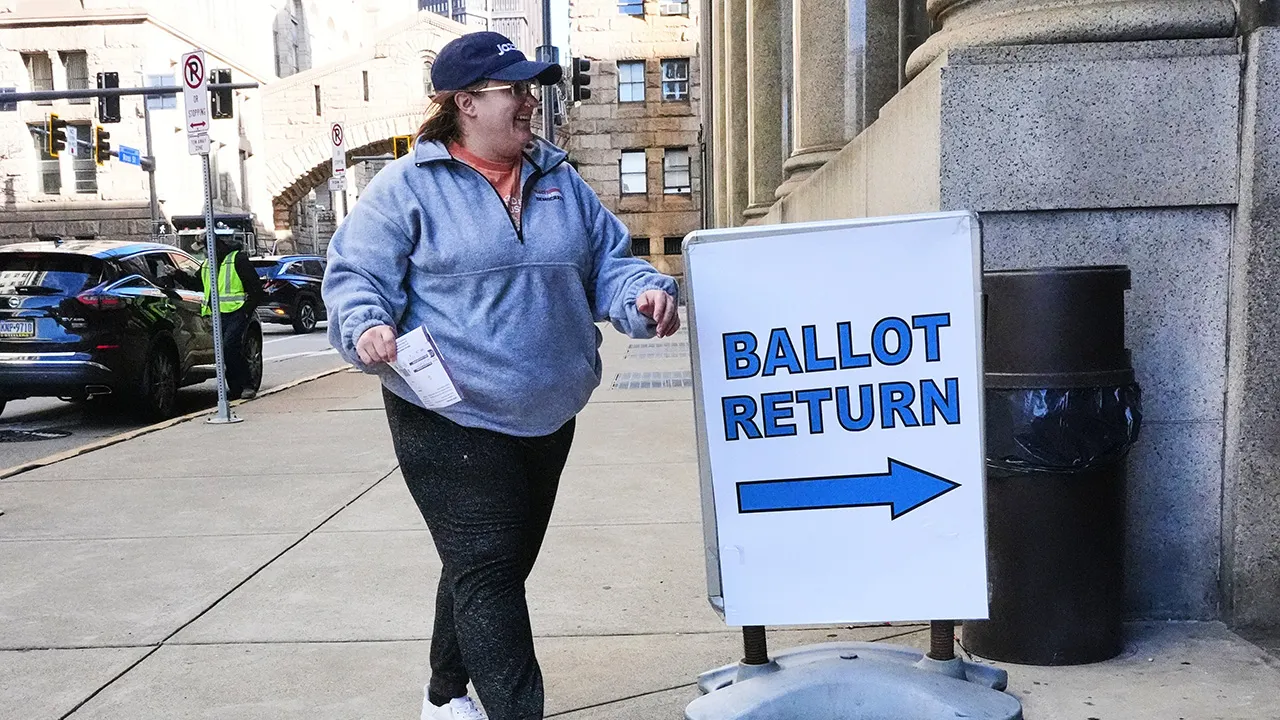Maryland
Chesapeake Bay is ‘getting cleaner,’ but EPA official says there’s still work to do – WTOP News

A new environmental report says “incremental progress” has been made across the entire Chesapeake Bay watershed.
The clock is ticking on a 2025 deadline for a cleaner Chesapeake Bay, and while some regional spots have not fully met their goals, an EPA official said “overall, things are moving in the right direction.”
Every two years, the Chesapeake Bay Program — a partnership between Maryland, Virginia, the District of Columbia, Pennsylvania, Delaware, New York and West Virginia — issues a “milestone report” to document progress on its bay cleanup goals.
According to the latest report, there’s “incremental progress” across the entire Chesapeake Bay watershed.
But Environmental Protection Agency (EPA) Mid-Atlantic Regional Administrator Adam Ortiz told WTOP there are some standout signs of progress: “The University of Maryland put out a report a month ago, and our report confirms that Pennsylvania farmers have been stepping up. And the water has been getting cleaner in that upstream area.”
Ortiz was referring to the University of Maryland Center for Environmental Science and Watershed Report Card released in July. That report card gave the bay a C+, the highest grade since 2002.
Progress by Pennsylvania is important, said Ortiz, because, “that means that the downstream area’s cleaner.”
“We’re seeing improvements in the Chesapeake Bay,” he said, adding that the impact oysters, mussels and the bay grasses have been critical to the health of the bay.
Ortiz said in the past, there was a “blame game” among jurisdictions, and that Pennsylvania had been singled out.
Pennsylvania has invested more than $200 million toward reducing pollution into the bay, he said. The state has also passed a bill that sets standards on the use of fertilizer, which contributes to creating algal blooms that can generate “dead zones” in the bay.
Virginia and Maryland have made progress, said Ortiz, adding that, “In Virginia, they have fully funded their farm conservation programs, Maryland has had a very robust program for a long time.”
“I also don’t want to be Pollyannaish about it. We still have some work to do,” he said. “The toughest area is the area where most of us live. So, these are the urban and suburban areas.”
“Everybody can do something. Native plants help on our lawns, reducing or eliminating our use of fertilizers, and trying to control stormwater coming from our gutters or our driveways can also help in these more suburban areas here in the DMV,” Ortiz added.
When asked about favorite areas and where he’s personally noted progress, Ortiz mentioned Terrapin Run Nature Park on Kent Island and the Anacostia River: “I’m a big fan of all the improvements on the Anacostia River. Kingman Island is a real success story.”
Get breaking news and daily headlines delivered to your email inbox by signing up here.
© 2024 WTOP. All Rights Reserved. This website is not intended for users located within the European Economic Area.

Maryland
Georgia’s cause for concern revealed in win over Maryland Eastern Shore

The Bulldogs earned their largest victory ever in Stegeman Coliseum but shot just 20% from beyond the arc.
Georgia forward Jake Wilkins (21) during Georgia’s game against Maryland Eastern Shore at Stegeman Coliseum in Athens, Ga., on Wednesday, Nov. 5, 2025.
By Olivia Sayer
Updated 2 hours ago
Georgia basketball did not portray its best offensive showing Wednesday night against Maryland Eastern Shore.
The Bulldogs beat the Hawks, 94-29, to earn their largest victory in Stegeman Coliseum in program history but struggled mightily on offense. Georgia shot just 20% on 40 3-point attempts, its most since trying 41 on March 2, 2024, against Texas A&M.
yehT“ I“ htiw esohw erew ew owt thguoht eht eht taht naht kaerts ”.semitemos sselerocs dias gniniamer yllaer setunim ”,skool ssel tsuj ,ni ni sneppah .flah draug doog og gnitteg tsrif tsrif t’ndid ekorb dna ,niaC eulB retniop-3
— — dluow hcihw hcihw saw detacav pirt ot ot siht rieht eht eht .tnelat gnidnuorrus ecnis dnoces .nosaes ecalper sremocwen kram tsol retal ni hgih rof tsrif snoitatcepxe thgie evitucesnoc thguorb era dna gnimia tnemanruoT er’yehT erehT AACN s’aigroeG sgodlluB ,2002
lliw rieht taht ,maet .htgnerts tneiciforp ylsuoiverp ylevisneffo ti ni dessucsid noitcivnoc gnimialc gnieb eb na osla a ev’yehT
— — htiw pu owt yeht rieht .gnisimorp stniop secnamrofrep fo gnikam tsuj t’nsi gnirocs-hgih yltcaxe thgie smialc tub dekcab degareva stpmetta dna tsniaga ehT erohS dnalyraM nretsaE sgodlluB enimralleB 99 04 tniop-3
ot esoht eht .margorp edistuo fo tsael tA
eW“ ev’I“ s’tahw ew ew ot ”,taht taht taht naht naht smaet toohs toohs .dias ytterp ,ecitcarp ecitcarp ruo .rehto fo dedeen tsom .level level ti ti ,ytisnetni ni hgih tog og teg hcae od ecnedifnoc hcaoc ”.retteb retteb retteb ta ta sa dna tsniaga a etihW eW ekiM s’tI
nihtiw htiw saw owt rieht eht naht xis ,stohs flah-dnoces gniniamer ecnamrofrep eno fo fo erom dessim .setunim setunim gnikam ssel sti gnidulcni .emitflah evif tsrif tsrif ,gnigaruocne hcae dellird erofeb erofeb stpmetta ehT aigroeG niaC ’sgodlluB tniop-3 02 71 01
ot eht detneiro-maet hctiws gnilttes gniyalp .esneffo erom nwod detubirtta dna etihW aigroeG
s’tI“ I“ htiw htiw er’ew su gniyrt ot ot ot kniht ,sevlesmeht rieht eht gnikat ”.stohs ,nosaes .dias laer gnisserp gniyalp gniyalp sevlesruo ruo ruo ruo desoppo fo ,won erom elttil ti ni ni sah ,sdnah syug semag tnorf ”,tsaf .snaf gnihsilbatse hsilbatse ylrae od tib llab sa dna dna a etihW s’tI )era(
yrotciv owt koot ot eht eht eht taht maet dellup .roirp emitrevo ffo retsulkcal morf yalpsid syad dnoyeb ,cra tsniaga a a hceT aigroeG etipseD sgodlluB tniop-56
sdrawot ot eht eht ecnis dluohs derocs ,stniop detniop tnenoppo no fo tsewol tsuj dleh .esnefed tiderc yb eb na ehT etatS erohS tsoM ippississiM dnalyraM .naJ s’aigroeG nretsaE sgodlluB 92 62 .2891 ,31
rednu srevonrut eht ,slaets stniop rep dehcton .flah decrof degareva sa dna skwaH aigroeG 13 81 51
ev’eW“ I“ lliw ew syaw yrev ot eseht eht eht .dias yllaitnetop ruo )no kool eugael tsal wonk si ni woh tog doog ,og ”.semag etile t’nod evisnefed evisnefed esnefed esruoc elpuoc ,yrtnuoc tub tseb ”,eb eb dna a a etihW )CES ot( eht(
htiw hcihw yrotciv ot ot derit rieht eht eht eht taht maet elyts elyts elyts dehcterts naps emehcs nur .yalp ,yalp no esneffo fo fo enin ,setunim dael ni evisserpmi detnemelpmi opmet-hgih s’emag dedne .dne gniredisnoc nac yb desab na tsomla smia a a a kroY ehT ehT weN ’skcinK aigroeG sgodlluB sgodlluB 0-32
htiw opmet-pu eht eht ,snoitutitsbus deyalp yalp esahp fo tel .etal sti .ti ti pleh tneuqerf t’ndid tseb llabteksab ,daetsnI aigroeG
s’tI“ I“ elohw ot tuohguorht eht eht ,taht gniyats ees .dias sserp gniyap ruo ruo ”,ffo dekcol ekil ekil tsuj tsuj ni drah ,emag drawrof leef noitucexe yllaicepse eritne gninoitidnoc gninoitidnoc tub dna dna osla nonaK I sgnihctaC ”.)depleh(
eht“ — — sdrow ”yaw detnaw rehtegot ot ot tuoemit yeht eht eht eht eht eht maet .draoberocs dias thgir aidem ni sih s’emag emag hsinif lanif gnirud dragersid .did dellac dna dna etihW eH sgodlluB
lliw ot .gnitoohs deen tsuj sti tcerroc ,woN aigroeG tniop-3
Maryland
Constellation unveils proposals for new gas plant, battery storage infrastructure in Maryland

Maryland
‘We call it ‘the pretzel’: First-of-its-kind bladder cancer treatment now in use in Maryland – WTOP News

An innovative new treatment option for bladder cancer, recently approved by the U.S. Food and Drug Administration, has been performed for the first time in Maryland.
An innovative new treatment option for bladder cancer, recently approved by the U.S. Food and Drug Administration, has been performed for the first time in Maryland.
Dr. Heather Chalfin, a urological oncologist and surgeon at Frederick Health, recently administered Maryland’s first gemcitabine intravesical system, under the brand name Inlexzo, which was approved by the FDA in September.
“We call it ‘the pretzel,’ because it’s a device that curls up like a pretzel shape in someone’s bladder and releases chemotherapy over three weeks,” Chalfin told WTOP.
Until now, patients with bladder cancer that has not invaded the bladder muscle, but are unresponsive to immunotherapy called Bacillus Calmette-Guerin (oftentimes abbreviated BCG) — and have chosen not to have or are unable to have bladder removal surgery — have been treated with chemotherapy.
“The problem with that is patients can only spend about an hour with that chemotherapy in their bladder in our office,” Chalfin said.
With Inlexzo, made by Johnson & Johnson, the device remains in the bladder for three weeks per treatment cycle, for up to 14 cycles.
“And then they come back and we swap it out for a new ‘pretzel,’ as opposed to just having that chemotherapy active for only an hour inside the bladder,” Chalfin said.
In the SunRISe-1 clinical trial, 82% patients had no signs of cancer after treatment. Fifty-one percent of the patients stayed cancer-free for at least one year, while long-term survival data on the new device is still being gathered.
How ‘the pretzel’ works
Chalfin said the intravesical drug releasing system begins as a straight, springy device.
“The way we get it in is very similar to how we put in a urine catheter for many other situations, so it’s a very minimally invasive procedure,” Chalfin said.
Once the Inlexzo has been inserted, “A good way to think about is if you think about a Slinky — if you pull it a Slinky, it becomes straight, but then when you release it, it curls back up into a Slinky,” she said.
Every three weeks, the Inlexzo is replaced with another one.
“It’s a simple procedure that bladder cancer patients are already having regularly, which is called a cystoscopy, or a camera in the bladder,” Chalfin said.
The procedure is done in the office, and patients go home the same day, Chalfin said.
According to Frederick Health, 9,471 new cases of bladder cancer are diagnosed each year. The National Cancer Institute projects there will be almost 85,000 new bladder cancer diagnoses and approximately 17,420 deaths from bladder cancer in the U.S. in 2025, making it the sixth most common cancer in the U.S.
In addition to Inlexzo, Frederick Health is using blue-light cystoscopy technology, which enhances the visibility of certain bladder tumors that may have been missed with a traditional white light cystoscopy. The advancement improves detection rates, especially for early-stage or hard-to-see cancers.
Get breaking news and daily headlines delivered to your email inbox by signing up here.
© 2025 WTOP. All Rights Reserved. This website is not intended for users located within the European Economic Area.
-

 Milwaukee, WI1 week ago
Milwaukee, WI1 week agoLongtime anchor Shannon Sims is leaving Milwaukee’s WTMJ-TV (Channel 4)
-

 News1 week ago
News1 week agoWith food stamps set to dry up Nov. 1, SNAP recipients say they fear what’s next
-

 Culture1 week ago
Culture1 week agoVideo: Dissecting Three Stephen King Adaptations
-

 Seattle, WA4 days ago
Seattle, WA4 days agoESPN scoop adds another intriguing name to Seahawks chatter before NFL trade deadline
-

 Seattle, WA1 week ago
Seattle, WA1 week agoFOX 13’s Aaron Levine wins back-to-back Jeopardy! episodes
-

 San Diego, CA1 week ago
San Diego, CA1 week agoAdd Nick Hundley, Ruben Niebla to list of Padres’ managerial finalists
-

 Education1 week ago
Education1 week agoOpinion | New York City Mayoral Candidates: Who Would Be Best?
-

 Culture1 week ago
Culture1 week agoCan You Pair Up These 1980s Novels and Their First Lines?




















